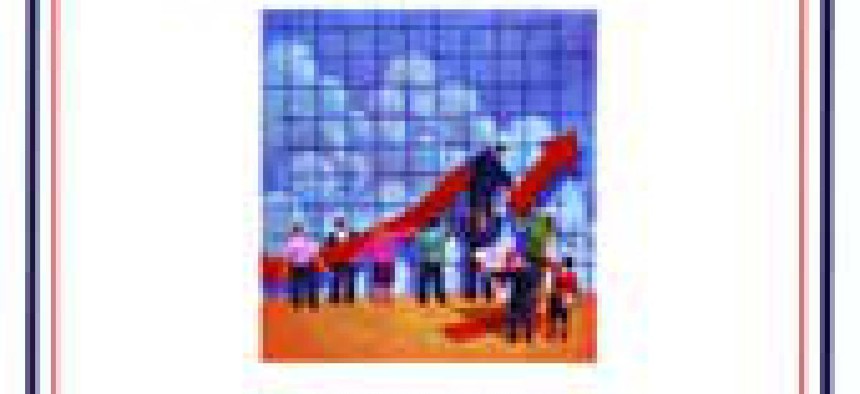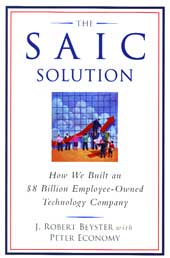The SAIC Story: An $8 billion business success

Company founder J. Robert Beyster recounts SAIC's beginnings.
Perhaps you've already been introduced to Science Applications International Corp. Maybe you're one of the tens of thousands of people who have worked for the company since I founded it in 1969, or perhaps you're working on one of the company's 9,000 current contracts.Or you might be one of SAIC's current or former customers in the public or private sector, a list that includes a veritable Who's Who of federal government leaders and agencies (including the Defense, Energy and Homeland Security departments; the Federal Aviation Administration; NASA and many more); a variety of state and local governments; commercial firms such as Southern California Edison, Entergy, Pfizer, and other Fortune 100 companies; and international customers such as British Petroleum, the Saudi Royal Naval Forces, and Scottish Power.Or you might even be one of SAIC's new shareholders. This company ? employee-owned since the very beginning ? recently completed an initial public offering in October 2006, raising $1.13 billion.But even if you're not familiar with SAIC and its remarkable story, you've surely felt its impact on your own life. If you've ever wondered how the nation's intelligence services track down and capture elusive terrorists by sifting through mountains of electronic data gathered by the nation's intelligence services, you may have encountered just one example of SAIC's vast array of leading-edge database technologies. If someone you know has faced the challenge of beating cancer or AIDS, SAIC has been active in the search for cures in its role as Operations and Technical Support Contractor for the National Cancer Institute's Frederick Cancer Research and Development Center. Or, if you surfed to a Web site, the pathways your computer followed from your desktop to its ultimate destination were paved by one of SAIC's former subsidiaries, Network Solutions Inc.Some say that SAIC is the best company that most people have never heard of. On one hand, much of SAIC's mainline work has been on federal contracts ? many of which involved classified programs that are intentionally kept out of the public eye. But on the other hand, SAIC is an incredibly eclectic company ? a decentralized organization that explicitly encourages and rewards entrepreneurial upstarts and initiatives in new project areas and with new customers ? and it has touched the everyday lives of many people in the United States and beyond, often in unexpected ways.SAIC's environment is one where creativity, innovation and entrepreneurship are more than management buzzwords ? they are the company's core principles. Over the past 38 years, SAIC has managed and performed on tens of thousands of contracts and it has a hard-earned reputation for succeeding on the "tough" jobs ? the very complex technical and important problems few companies are willing or able to tackle.Instead of focusing on only a handful of large customers working on a small number of large contracts, SAIC historically has taken a different tack, also engaging in thousands of relatively small-dollar jobs ? representing an incredibly diverse array of different projects and customers across many market sectors.Some observers might view this symbiotic mix of government and commercial business as a vice, because of the challenge of focusing on so many different kinds of businesses with so many different customers. However, SAIC's diversity of customers and contracts was a virtue and not a vice, and it was a way of life for our employees. More importantly, it was a key defense mechanism for protecting the company from market and environmental changes beyond our control.SAIC's success was the result of the convergence of innovative technology and innovative business practices. When I decided to start the company, my motivation wasn't financial. I wanted to create a company that would attract talented scientists and engineers who would tackle nationally important scientific issues. And they would stay at SAIC because of the challenging problems and a work environment that encouraged creative thinking.As this unique workplace evolved, a number of business principles and practices emerged. Five of these twelve principles and practices, explored in greater depth in subsequent chapters, are summarized here: Over its many years, SAIC put people first ? the organization was expected to serve customers, employees and owners (who were employees), not the other way around. The basic formula worked exceedingly well: Hire very smart people, encourage their entrepreneurial spirit, let them focus on customers and reward them for their contributions. SAIC was specifically designed to be an organization where managers and employees would be free to pursue work they were passionate about ? to start, operate, control and grow their own business units under the umbrella of the parent company, and unleash their own energy and creativity. Although they were encouraged to build and run their own business, employees were expected to follow company practices for bidding and contracting and adhere to the highest ethical standards in the process to protect their customers' and the company's best interests. SAIC was a company founded by scientists, and it used science and engineering to provide the most effective, efficient, up-to-date and highest quality solutions for specific client problems. The company put a premium on hiring the most talented scientists and engineers it could find, pointing them toward problems of national importance, and then getting out of the way. We believed in and valued small beginnings. As our experience showed, small things often beget large things. Although SAIC eventually performed on a wide variety of projects, science and engineering has always remained deep within the company's core. If freedom of movement was the incentive that drew talented people into SAIC, then employee ownership was the glue that kept them there. SAIC built a culture firmly rooted in the simple idea that those who contribute to the company should own it, and ownership should be commensurate with a person's contribution and performance. Without employee ownership, SAIC would not exist today. At SAIC, employees were not only expected to contribute their ideas to improve the company and the services it provided, but also to make decisions that would put their ideas into action. While there was certainly a hierarchy of various managers and employees, the expectation was that decisions would be made at the lowest level possible, and problems resolved at the lowest appropriate level, thus cutting red tape and providing customers with more responsive service.In the chapters that follow, we consider how each of these principles and practices led to SAIC's extraordinary success, and how the lessons that we learned over the years can help you create your own business success stories if you are so inclined. Finally, in Chapter 14, I take a look at the future of employee ownership, American business competitiveness, science and technology, and SAIC. As you will see, there is much to be hopeful about, and much work to be done.
 Below is the first chapter of Robert Beyster's book on the philosophy and principles that created and built Science Applications International Corp., the company he founded in 1969. The book, "The SAIC Solution: How We Built an $8 Billion Employee-Owned Technology Company," was published March 30.
Below is the first chapter of Robert Beyster's book on the philosophy and principles that created and built Science Applications International Corp., the company he founded in 1969. The book, "The SAIC Solution: How We Built an $8 Billion Employee-Owned Technology Company," was published March 30.
People first.
Freedom (with strings attached).
From science to solutions.
Employee ownership.
Participation in decision making.
Adapted and reprinted by permission of John Wiley & Sons from "The SAIC Solution: How We Built an $8 Billion Employee-Owned Technology Company" by J. Robert Beyster with Peter Economy. Copyright 2007 The Foundation for Enterprise Development. All rights reserved.

People first.
Freedom (with strings attached).
From science to solutions.
Employee ownership.
Participation in decision making.
Adapted and reprinted by permission of John Wiley & Sons from "The SAIC Solution: How We Built an $8 Billion Employee-Owned Technology Company" by J. Robert Beyster with Peter Economy. Copyright 2007 The Foundation for Enterprise Development. All rights reserved.
NEXT STORY: BearingPoint rolls into new territory

